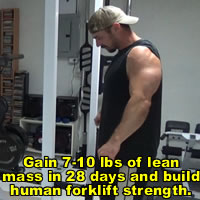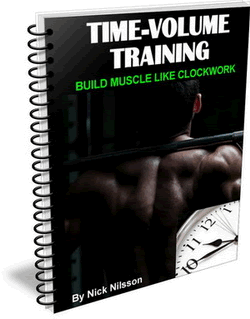By Nick Nilsson
Author of Time-Volume Training
So you're stuck...haven't gained any muscle in months...the scale hasn't gone up and neither have the weights you're using.
What do you do? How do you step back and assess what you're doing and where you're going wrong? Just randomly changing things with your program and your eating isn't going to cut it...

That's where the Muscle-Building Troubleshooter comes in.
This step-by-step guide will walk you through what you need to do to analyze what's stopping you from achieving the results you want and help to get you back on the right track to muscle growth.
And, don't be shocked when I don't start throwing out info about your NO2 deficiency and the need for some expensive crap supplement with ingredients you can't pronounce...this is the real deal.
STEP 1 - NUTRITION
There's an old saying that you can't out-train a bad diet. Totally true. You don't have to eat perfectly but if you're not eating ENOUGH or if you're eating the wrong foods or at the wrong times, you just won't gain muscle. Simple as that.
So step back and have a look at what you're eating. Write down EXACTLY what you're eating over the course of a few days, covering both training and non-training days.
Be sure to log EVERYTHING, including what TIME you ate. Go through these steps one-by-one.
1. Are you eating protein foods with every meal?
| If NO, make sure you eat some with EVERY meal. Your body needs protein to build muscle tissue. | |
| If YES, go to #2... |
2. How much total protein are you eating over the course of the day?
| If less than 1 gram per pound bodyweight, you need to eat more. Without sufficient protein, muscle-growth stops. Better to err on the side of too much than not enough. A little extra protein will NOT hurt your kidneys, contrary to the myth. | |
| If equal to or more than 1 gram per pound bodyweight, go to #3 |
3. How many overall calories are you eating in a day?
| If less than your bodyweight (in pounds) multiplied by 15, you need more calories (e.g. 200 lbs x 15 = 3000 calories) | |
| If equal to or more than your bodyweight x 15, you STILL may need more calories but you're on the right track | |
| If more than your bodyweight x 20 and you're still not gaining, go to #5 |
4. What quality of food are you eating?
| If you eat more than 50% junk food, focus on bringing that down to 25% | |
| If you eat less than 25% junk food, you're on the right track - some is ok, especially if you need more calories in your diet, but you don't want to get too many calories from poor food sources - go to #6 |
5. How much fat are you eating?
| If you eat less than 30 grams of fat per day, that's NOT enough for muscle-building and optimal hormone production - increase that to at least 50 to 60 grams a day. | |
| If you eat more than 50 grams a day, look at what TYPE of fat it is...your body does need some saturated fat for hormone production. Stay away from processed fats but unprocessed animal fats can be useful. Go to #7 |
6. Are you eating very soon after training?
| If not, i.e. you're waiting more than 4 hours or so, this will hurt your progress. Take in something as soon as possible after training (e.g. protein shake) to start the anabolic processes going. About an hour after training, eat a big meal. | |
| If yes, go to STEP 2 to look at your training... |
STEP 2 - TRAINING
So now that you've got your nutrition in good order, THAT shouldn't be what's holding you back. It's time to look at your training...
1. How long are your training sessions?
| If greater than 1 hour, cut back NOW. Training longer than an hour decreases your testosterone below useful levels. Training for 45 minutes or less is better. | |
| If already less than an hour, go to #2 |
2. How many days a week are you training?
| If 5 or more times week and you're not gaining, reduce to 4 sessions per week. You may not be giving your body enough recovery time. | |
| If 1 or 2 times per week and you're not gaining, increase to 3 or 4 sessions per week. The body often needs a more frequent training stimulus in order to build muscle. | |
| If you're at 3 or 4 times per week, and you're not gaining, go to #3 |
3. What types of exercises are you using?
| Curls, bench presses, and crunches...mirror-muscle syndrome. These exercises will not build significant muscle on their own...you need to focus on basic exercises like deadlifts, squats, and rows. | |
| Lots of machines...get off 'em. Free-weight exercises are MUCH more effective for building muscle. Anything that uses barbells, dumbbells or kettlebells is going to be far better. | |
| Free-weight exercises like squats, deadlifts, presses and rows. If you're already using these exercises and still not gaining, go to #4 |
4. How hard are you pushing yourself on your sets?
| Using lighter weight for higher reps (12+) and not getting close to failure...time to buckle down and get some weight on the bar. Use weights that push you to get 5 to 7 reps per set. | |
| Using VERY heavy weight for low reps (1 to 3). Time to back off a bit on the weight. Low reps are great for strength but aren't the best for building muscle mass. Use less weight and aim for 5 to 7 reps per set. | |
| Pushing to failure (and beyond using intensity techniques) on more than 1 or 2 sets per workout. Stop doing that NOW. Pushing to the limits like this may feel good in the short-term but isn't the most effective way to train for muscle mass. It compromises recovery by bringing down the nervous system and slows growth by inducing excessive muscle damage. Some is necessary but too much can be counterproductive. | |
| Pushing to near failure (when doing lower-volume routines) or staying away from failure (when doing higher-volume routines) and still not gaining, go to #5 |
5. What type of program are you using?
| Using a low-volume, high-intensity style of program like Mike Mentzer's "High Intensity Training" and not gaining, your body may need a break. Switch to higher-volume, lower-intensity training for 3 to 4 weeks. | |
| Using a volume-based program like Charles Staley's "Escalating Density Training" and not gaining, your body may respond better to lower volume but a more intense training stimulus. | |
| Using a program for more than 3 weeks without noticeable results...time to get a new program. If something doesn't get you results within 2 to 3 weeks, it's not EVER going to work for you. An effective program will start working within that timeframe. Go to #6 |
6. What bodyparts are you focusing on?
| Training a lot of arms and chest...back to the mirror muscle problem. The arms and chest don't contain that much muscle mass and working them doesn't stimulate much testosterone production. Time for a more balanced program - work your legs or suffer the consequences of looking like you're riding a chicken. | |
| Nothing in particular but covering all bodyparts. This is better but if you're still not gaining, it's time to eliminate the training for the smaller bodyparts such as arms and calves that can affect recovery but not contribute much to overall muscle growth. This will allow you to put all your energy into the big exercises like squats, deadlifts and heavy presses and rows. | |
| Just legs...I only work my legs. You're just a figment of my imagination...you don't exist... |
STEP 3 - SUPPLEMENTATION
Now we come to the section that most trainers seem to want to START with...supplements. Contrary to what the ads in the magazines will tell you, training and nutrition actually ARE more important than supplements.
Just look at the standout physiques of the "Golden Age" of bodybuilding, before fancy supplements and steroids came into the picture...Chuck Sipes, John Grimek, Bill Bearl, Steve Reeves, Reg Park, and MANY more.
I can promise you these guys knew their stuff when it came to training and eating.
1. Are you taking a protein supplement?
| If no - this is the best place to start. A good protein supplement will help you get enough protein to support muscle growth throughout the day and in the important post-workout period. | |
| If yes, go to #2 |
2. Are you taking a good multivitamin/multimineral supplement?
| If no, this is a critical mistake. Your body requires vitamins and minerals to function properly. Without optimum levels, you are compromising results. Sure, doctors say you can get the RDA without supplements but who wants to have just enough to avoid deficiency? When building muscle, you need EXCESS, not "just enough." | |
| If yes, go to #3 |
3. Are you taking creatine?
| If no, you may be missing out on some serious results. Creatine is one of the very few PROVEN supplements that can help you build muscle and strength. It is well-researched and very safe. It is highly recommended. | |
| If yes, go to #4 |
4. That's it for supplements...there really isn't anything else proven to really help with muscle-building that I would recommend as a "missing link" in your results.
And honestly, if you're not doing the training and nutrition right, even the protein, vitamins and creatine aren't going to help you build muscle. Which brings us to...
THE MAIN LESSON
When you're stuck in a muscle-building plateau, look first at your nutrition, then at your training then, and ONLY then, your supplementation. By systematically going through the Troubleshooter above, you'll be able to pinpoint what you need to change to get your mass moving in the upwards direction again.
Learn 4 no-fail methods for quick and easy weight gain here.
![]()
More From Fitstep.com
Share This Page...
---
Home -> Muscle and Strength -> Tips and Articles ->Troubleshooter



